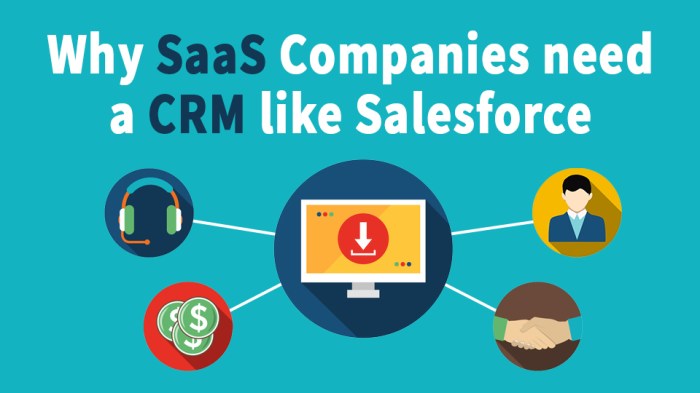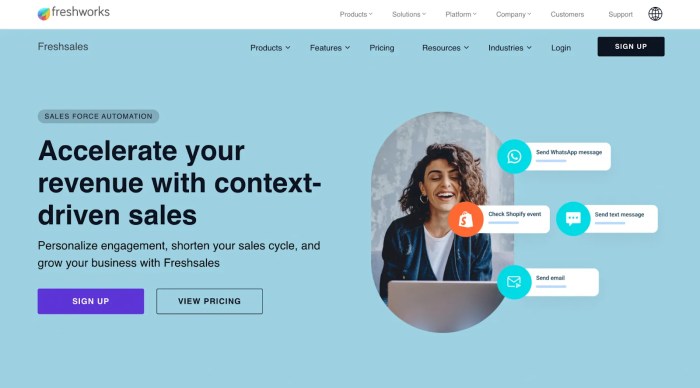CRM software for SaaS companies is more than just contact management; it’s the engine driving growth, customer retention, and ultimately, profitability. This exploration delves into the unique needs of SaaS businesses, examining how the right CRM system can streamline sales processes, improve customer relationships, and contribute significantly to a company’s bottom line. We’ll navigate the complexities of choosing, implementing, and leveraging CRM features to maximize ROI and achieve sustainable growth within the dynamic SaaS landscape.
From defining crucial KPIs and integrating with other SaaS tools to mastering advanced applications like predictive analytics and personalized communication, we will provide a comprehensive guide for SaaS companies of all sizes. We’ll also address the practical aspects of CRM implementation, including cost considerations, data migration strategies, and overcoming potential challenges. This guide aims to empower SaaS businesses to make informed decisions about their CRM strategy, ultimately leading to increased efficiency and sustained success.
Defining SaaS CRM Needs
SaaS companies have unique CRM requirements compared to other industries. Their needs extend beyond basic contact management to encompass functionalities crucial for managing subscriptions, tracking usage, and optimizing customer lifecycle engagement. This section Artikels those specific needs, key performance indicators (KPIs), and integration strategies.
Unique CRM Requirements for SaaS Businesses
Unlike traditional businesses, SaaS companies rely heavily on recurring revenue models. Their CRM needs to seamlessly integrate with billing systems to manage subscriptions, track churn, and forecast future revenue. Furthermore, the ability to track product usage and link it to customer interactions is crucial for understanding customer value and identifying potential upselling opportunities. Effective onboarding and support processes are also vital, requiring a CRM system that facilitates seamless communication and knowledge sharing across teams.
Key Performance Indicators (KPIs) for SaaS CRM Success
Three critical KPIs for SaaS CRM success are Customer Churn Rate, Monthly Recurring Revenue (MRR), and Customer Lifetime Value (CLTV). These metrics provide insights into the health of the business and the effectiveness of the CRM system in driving growth.
- Customer Churn Rate: This measures the percentage of customers who cancel their subscriptions within a given period. A low churn rate indicates strong customer satisfaction and retention. A CRM system can help identify at-risk customers by tracking engagement levels and support interactions.
- Monthly Recurring Revenue (MRR): This represents the predictable revenue generated from subscriptions each month. A CRM system helps track MRR growth, identifying trends and opportunities for expansion.
- Customer Lifetime Value (CLTV): This metric predicts the total revenue a customer will generate throughout their relationship with the company. A CRM system helps to understand customer behavior and predict CLTV, enabling targeted marketing and retention efforts.
Integrating CRM with Other SaaS Tools
Seamless integration between the CRM and other SaaS tools, such as marketing automation platforms (e.g., HubSpot, Marketo), billing systems (e.g., Stripe, Zuora), and help desk software (e.g., Zendesk, Intercom), is essential for a holistic view of the customer journey. This integration enables automated workflows, improved data accuracy, and enhanced efficiency.
Hypothetical CRM Implementation Plan for a Rapidly Growing SaaS Startup
A sample implementation plan for a rapidly growing SaaS startup would involve phased rollout. Phase 1 focuses on core functionalities like contact management and sales pipeline tracking. Phase 2 integrates marketing automation and billing systems. Phase 3 introduces advanced features like predictive analytics and customer segmentation. Throughout, ongoing training and user feedback are crucial for successful adoption.
Feature Comparison of Top CRM Systems
Several leading CRM platforms cater to the specific needs of SaaS companies. This section compares three prominent options, highlighting their strengths and weaknesses, pricing models, and integration capabilities.
Comparison of Leading CRM Platforms
| Platform Name | Key Features | Pricing Model | Integration Capabilities |
|---|---|---|---|
| Salesforce Sales Cloud | Comprehensive features, robust automation, advanced analytics | Subscription-based, tiered pricing | Extensive API and AppExchange integrations |
| HubSpot CRM | Free and paid options, strong marketing automation integration, user-friendly interface | Freemium model, tiered pricing for advanced features | Good integration with HubSpot ecosystem and other popular tools |
| Zoho CRM | Cost-effective, wide range of features, customizable workflows | Subscription-based, tiered pricing | Good integration capabilities, supports various APIs |
Cloud-Based vs. On-Premise CRM Solutions
Cloud-based CRM solutions offer scalability, accessibility, and lower upfront costs, making them ideal for rapidly growing SaaS businesses. On-premise solutions provide greater control over data security but require significant upfront investment and IT infrastructure.
Improving SaaS Sales Processes with CRM Features
CRM features such as contact management, sales pipeline management, and reporting significantly enhance SaaS sales processes. Contact management ensures accurate customer data, enabling personalized communication. Sales pipeline management provides visibility into the sales process, facilitating better forecasting and resource allocation. Reporting provides data-driven insights into sales performance, helping to identify areas for improvement.
CRM Implementation and Integration Strategies
Successful CRM implementation requires a structured approach. This section provides a step-by-step guide, addresses potential challenges, and Artikels best practices for data migration and integration.
Step-by-Step CRM Implementation Guide
- Needs Assessment: Define specific requirements and choose the right CRM system.
- Data Migration Planning: Develop a comprehensive data migration plan to minimize disruption.
- System Configuration: Customize the CRM to match business processes.
- User Training: Provide comprehensive training to all users.
- Go-Live and Monitoring: Launch the system and monitor performance closely.
Challenges During CRM Implementation and Solutions
Potential challenges include data inconsistencies, resistance to change, and insufficient user training. Solutions involve thorough data cleansing, change management strategies, and comprehensive training programs.
Best Practices for Data Migration

Best practices include data cleansing, validation, and transformation before migration. A phased approach, starting with a pilot group, minimizes risk.
Integrating CRM Data with Marketing and Sales Analytics Dashboards, CRM software for SaaS companies
Integrating CRM data with marketing and sales dashboards provides a unified view of customer interactions and performance. This enables data-driven decision-making and improved efficiency.
Advanced CRM Applications in SaaS
CRM systems offer advanced functionalities beyond basic contact management. This section explores how CRM can improve customer onboarding, retention, support, and personalization.
Improving Customer Onboarding and Retention
CRM systems can automate onboarding workflows, track customer engagement, and identify at-risk customers, leading to improved retention rates. Personalized onboarding experiences, facilitated by CRM data, improve customer satisfaction and reduce churn.
Managing Customer Support Interactions

CRM systems centralize customer support interactions, improving response times and resolving issues more efficiently. Tracking support tickets and customer feedback provides valuable insights into customer satisfaction and areas for improvement.
Personalizing Customer Communications
CRM data enables personalized email campaigns, targeted offers, and customized support interactions, leading to increased engagement and customer loyalty.
Leveraging CRM Data for Predictive Analytics and Proactive Customer Service
A hypothetical scenario: A SaaS company uses CRM data to identify customers with low engagement scores. The system triggers automated alerts, prompting support agents to proactively reach out and address potential issues, preventing churn.
Cost and ROI of CRM Software
Implementing and maintaining a CRM system involves various costs. This section discusses these costs, methods for calculating ROI, and how CRM contributes to increased revenue and reduced customer acquisition costs.
Cost Factors Associated with CRM Implementation
Costs include software licenses, implementation fees, training expenses, and ongoing maintenance. The total cost depends on the chosen CRM system, the number of users, and the level of customization required.
Calculating Return on Investment (ROI)
ROI can be calculated by comparing the increased revenue and cost savings generated by the CRM system against the total cost of implementation and maintenance.
CRM’s Contribution to Increased Revenue and Reduced Customer Acquisition Costs
CRM systems contribute to increased revenue through improved sales efficiency, increased customer retention, and upselling/cross-selling opportunities. They reduce customer acquisition costs by enabling targeted marketing and efficient lead nurturing.
Cost-Benefit Analysis Template
A simple cost-benefit analysis template would include columns for initial investment, ongoing costs, increased revenue, cost savings, and net ROI over a defined period. This allows for a comparison of different CRM options.
Ultimate Conclusion: CRM Software For SaaS Companies
Successfully implementing and leveraging CRM software is paramount for SaaS companies striving for sustainable growth. By understanding the unique requirements of the SaaS industry, carefully selecting the right platform, and employing effective implementation strategies, businesses can unlock significant improvements in sales processes, customer relationships, and overall profitability. The journey from selecting a CRM system to realizing its full potential involves careful planning, ongoing optimization, and a commitment to data-driven decision-making.
This guide provides a framework for navigating this journey, equipping SaaS companies with the knowledge and tools to harness the power of CRM for lasting success.
FAQ Insights
What are the common mistakes to avoid when choosing a SaaS CRM?
Common mistakes include choosing a system with insufficient features for your needs, neglecting proper integration with existing tools, and failing to adequately train staff on the new system.
How can I measure the ROI of my CRM investment?
Track key metrics such as improved sales conversion rates, reduced customer acquisition costs, increased customer lifetime value, and enhanced customer satisfaction. Compare these metrics before and after CRM implementation.
What is the best approach to data migration to a new CRM?
Develop a comprehensive data migration plan, clean and validate existing data, use a phased approach to minimize disruption, and thoroughly test the migrated data for accuracy.
How often should my SaaS CRM system be updated?
Regular updates are crucial for security and functionality. Follow the vendor’s recommendations, typically involving automatic updates or scheduled maintenance releases.
